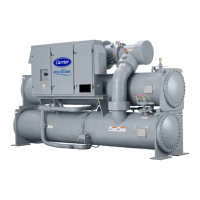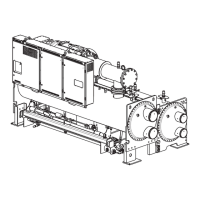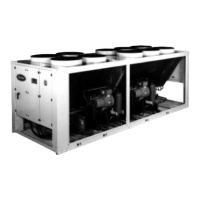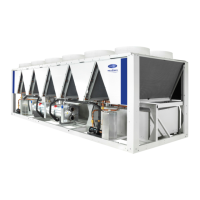37
PIC II System Functions
NOTE: Words not part of paragraph headings and printed in all
capital letters can be viewed on the CVC (e.g., LOCAL, CCN,
RUNNING, ALARM, etc.) Words printed in both all capital
letters and italics can also be viewed on the CVC and are
parameters (
CONTROL MODE ADDED EXAMPLES
, etc.)
with associated values (e.g., modes, temperatures, pressures,
percentages, on, off, enable, disable, etc.).Words printed in all
capital letters and in a box represent softkeys on the CVC (e.g.,
and ). See Table 3 for examples of the type of
information that can appear on the CVC screens. Figures 17-23
give an overview of CVC operations and menus.
CAPACITY CONTROL — The PIC II controls the chiller
capacity by modulating the slide valve in response to chilled
water temperature deviation away from the
CONTROL
POINT
. The
CONTROL POINT
may be changed by a CCN
network device or is determined by the PIC II adding any ac-
tive chilled water reset to the
SET POINT
. The PIC II uses the
PROPORTIONAL INC (Increase) BAND, PROPORTIONAL
DEC (Decrease) BAND
, and the
PROPORTIONAL ECW (En-
tering Chilled Water) GAIN
to determine how fast or slow to
respond.
CONTROL POINT
may be viewed or overridden
from the MAINSTAT screen.
ECW CONTROL OPTION — If this option is enabled, the
PIC II uses the
ENTERING CHILLED WATER
temperature to
modulate the slide valve instead of the L
EAVING CHILLED
WATER
temperature. The
ECW CONTROL OPTION
may be
viewed on the TEMP_CTL screen, which is accessed from the
EQUIPMENT SERVICE screen.
CONTROL POINT DEADBAND — This is the tolerance
range on the chilled water/brine temperature control point. If
the water temperature goes outside the
CHILLED WATER
DEADBAND
, the PIC II opens or closes the slide valve until
the temperature is within tolerance. The PIC II may be config-
ured with a 0.5 to 2 F (0.3 to 1.1 C) deadband.
CHILLED
WATER DEADBAND
may be viewed or modified on the
SETUP1 screen, which is accessed from the EQUIPMENT
SERVICE table.
For example, a 1º F (0.6º C) deadband setting controls the
water temperature within ±0.5º F (0.3º C) of the control point.
This may cause frequent slide valve movement if the chilled
water load fluctuates frequently. A value of 1º F (0.6º C) is the
default setting.
PROPORTIONAL BANDS AND GAIN — Proportional
band is the rate at which the slide valve position is corrected in
proportion to how far the chilled water/brine temperature is
from the control point. Proportional gain determines how
quickly the slide valve reacts to how quickly the temperature is
moving from the
CONTROL POINT
. The proportional bands
and gain may be viewed or modified from the SETUP2 screen,
which is accessed from the EQUIPMENT SERVICE table.
The Proportional Band
— There are two response modes, one
for temperature response above the control point, the other for
the response below the control point.
The temperature response above the control point is called
the
PROPORTIONAL INC BAND
, and it can slow or quicken
slide valve response to chilled water/brine temperatures above
the
DEADBAND
. The
PROPORTIONAL INC BAND
can be
adjusted from a setting of 2 to 10; the default setting is 6.5.
The response below the control point is called the
PROPORTIONAL DEC BAND
, and it can slow or quicken the
slide valve response to chilled water temperature below the
deadband plus the control point. The PROPORTIONAL DEC
BAND can be adjusted on the CVC from a setting of 2 to 10.
The default setting is 6.0.
NOTE: Increasing either of these settings causes the slide
valve to respond more slowly than they would at a lower
setting.
The PROPORTIONAL ECW BAND
can be adjusted on the
CVC display for values of 1, 2, or 3; the default setting is 2.
Increase this setting to increase slide valve response to a
change in entering chilled water temperature.
DEMAND LIMITING — The PIC II responds to the
ACTIVE DEMAND LIMIT
set point by limiting the opening of
the slide valve. It compares the
ACTIVE DEMAND LIMIT
set
point to the
DEMAND LIMIT SOURCE
(either the
AVERAGE
LINE CURRENT
or the
MOTOR KW
), depending on how the
control is configured.
DEMAND LIMIT SOURCE
is on the
RAMP_DEM screen. The default source is the compressor
motor current.
CHILLER TIMERS — The PIC II maintains 2 runtime
clocks, known as
COMPRESSOR ONTIME
and
SERVICE
ONTIME
.
COMPRESSOR ONTIME
indicates the total life-
time compressor run hours. This timer can register up to
500,000 hours before the clock turns back to zero. The
SER-
VICE ONTIME
is a reset table timer that can be used to indi-
cate the hours since the last service visit or any other event. The
time can be changed from the CVC to whatever value is de-
sired. This timer can register up to 32,767 hours before it rolls
over to zero.
The chiller also maintains a start-to-start timer and a stop-
to-start timer. These timers limit how soon the chiller can be
started.
START INHIBIT TIMER
is displayed on the MAIN-
STAT screen. See the Start-Up/Shutdown/Recycle Sequence
section, page 47, for more information on this topic.
OCCUPANCY SCHEDULE — The chiller schedule, de-
scribed in the Time Schedule Operation section (page 24), de-
termines when the chiller can run. Each schedule consists of
from 1 to 8 occupied or unoccupied time periods, set by the op-
erator. The chiller can be started and run during an occupied
time period (when
OCCUPIED ?
is set to YES on the MAIN-
STAT display screen). It cannot be started or run during an un-
occupied time period (when
OCCUPIED
?
is set to NO on the
MAINSTAT display screen). These time periods can be set for
each day of the week and for holidays. The day begins with
0000 hours and ends with 2400 hours. The default setting for
OCCUPIED ?
is YES, unless an unoccupied time period is in
effect.
These schedules can be set up to follow a building’s occu-
pancy schedule, or the chiller can be set so to run 100% of the
time, if the operator wishes. The schedules also can be by-
passed by forcing the
CHILLER START/STOP
parameter on
the MAINSTAT screen to START. For more information on
forced starts, see Local Start-Up, page 47.
The schedules also can be overridden to keep the chiller in
an occupied state for up to 4 hours, on a one time basis. See the
Time Schedule Operation section, page 24.
Figure 22 shows a schedule for a typical office building
with a 3-hour, off-peak, cool-down period from midnight to
3 a.m., following a weekend shutdown. Holiday periods are in
an unoccupied state 24 hours per day. The building operates
Monday through Friday, 7:00 a.m. to 6:00 p.m., and Saturdays
from 6:00 a.m. to 1:00 p.m. This schedule also includes the
Monday midnight to 3:00 a.m. weekend cool-down schedule.
NOTE: This schedule is for illustration only and is not
intended to be a recommended schedule for chiller operation.
Whenever the chiller is in the LOCAL mode, it uses Occu-
pancy Schedule 01 (OCCPC01S). When the chiller is in the
ICE BUILD mode, it uses Occupancy Schedule 02
(OCCPC02S). When the chiller is in CCN mode, it uses Occu-
pancy Schedule 03 (OCCPC03S).
The
CCN SCHEDULE NUMBER
is configured on the
NET_OPT display screen, accessed from the EQUIPMENT
ENTER
EXIT

